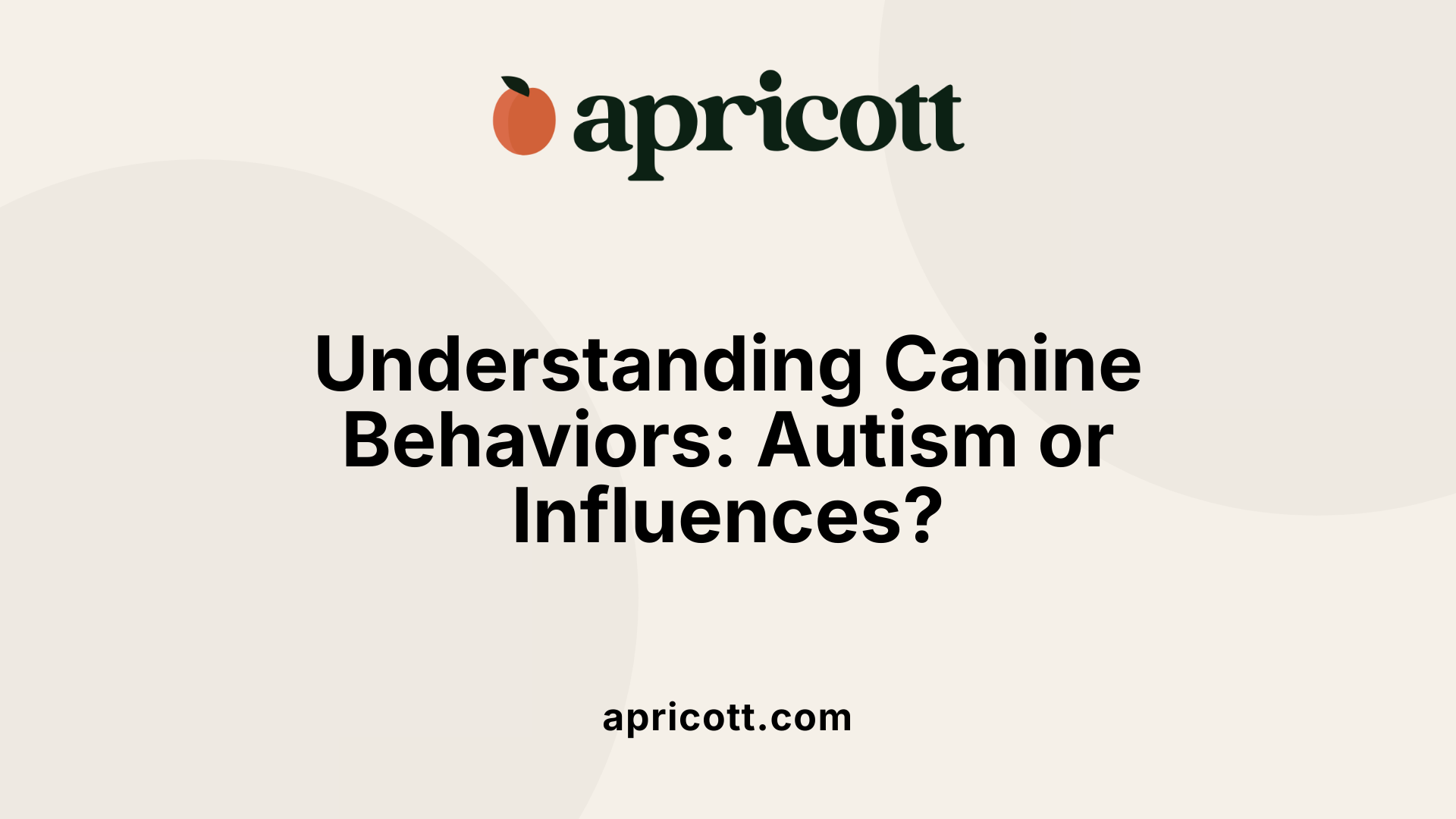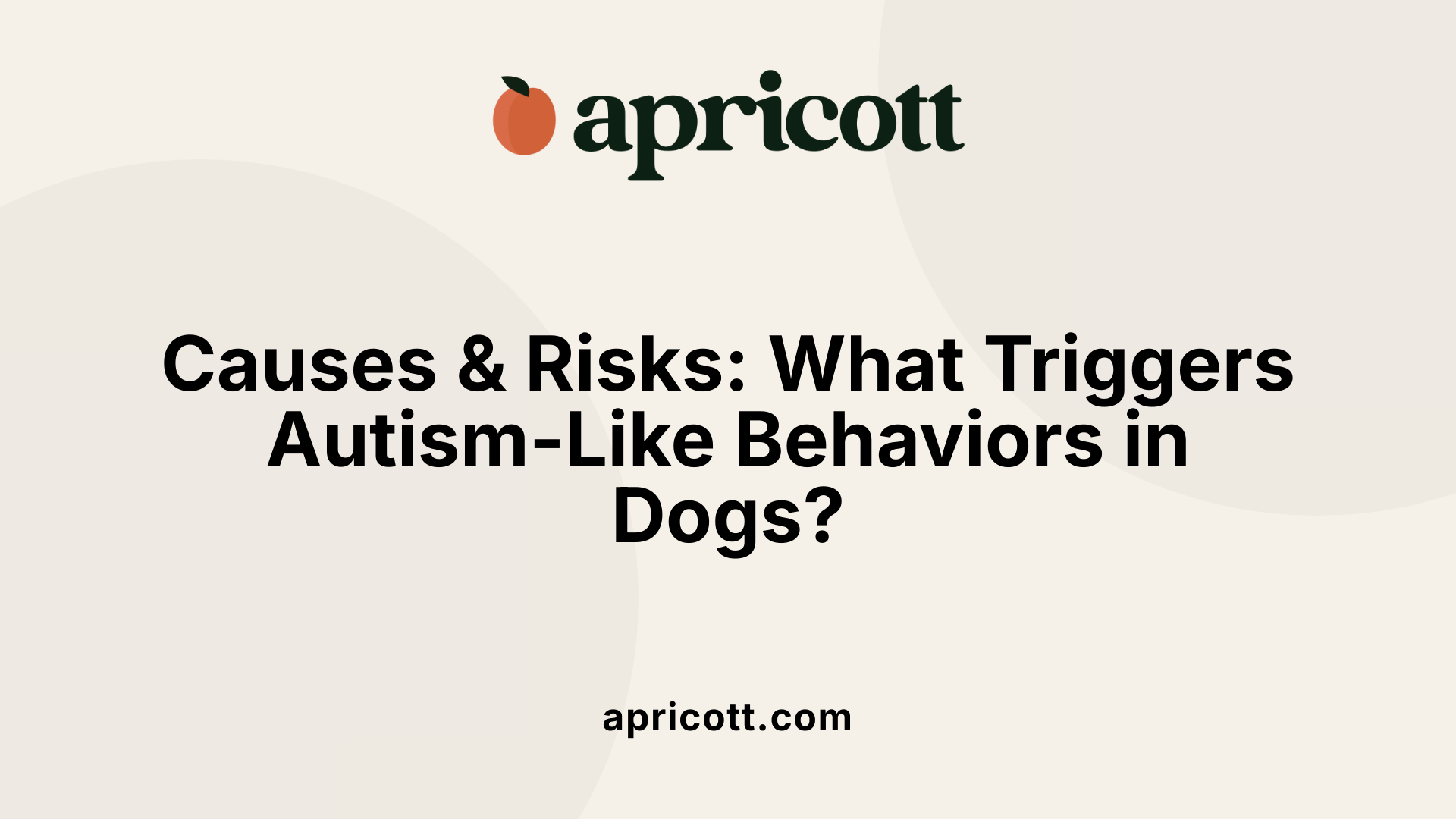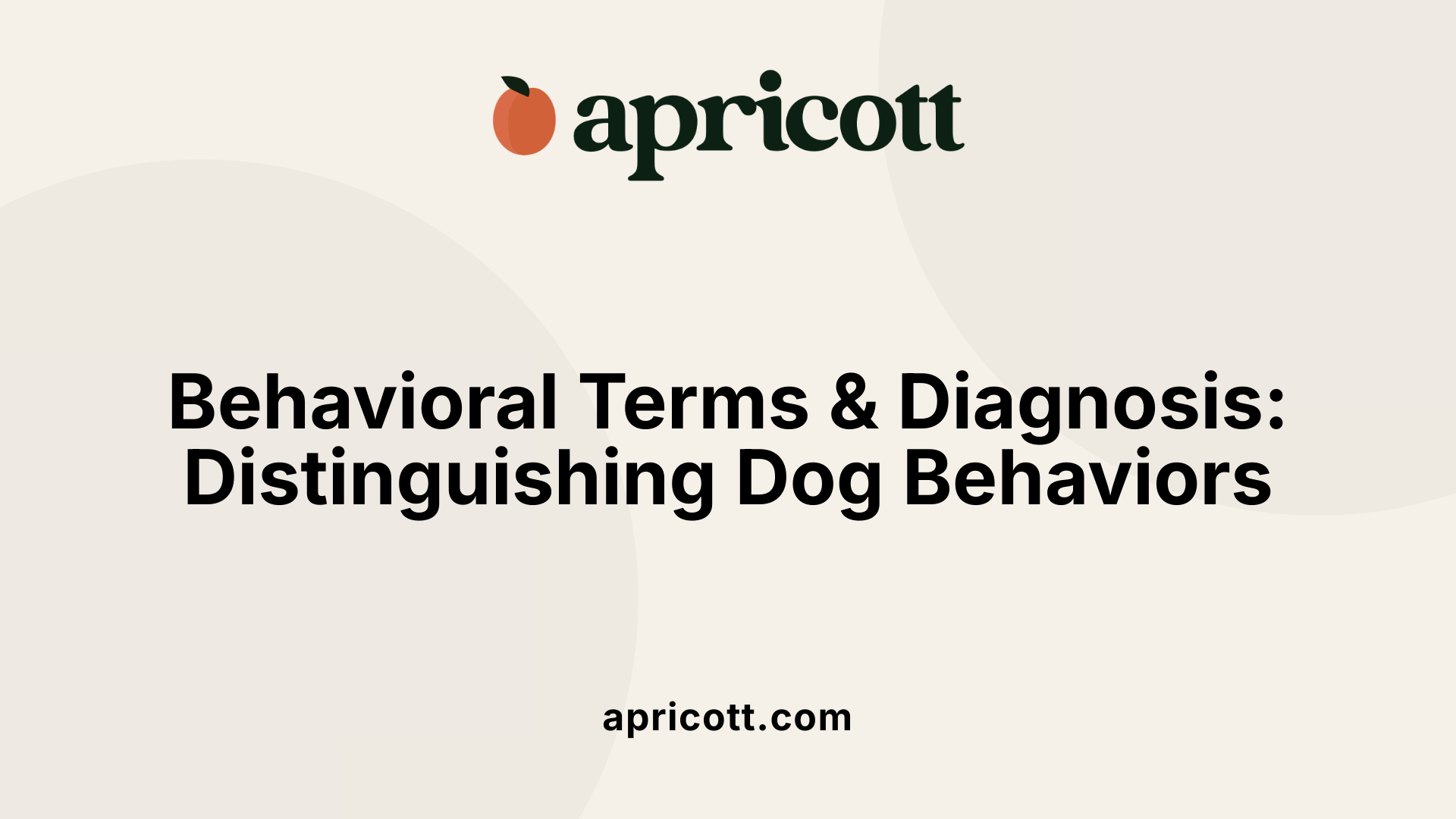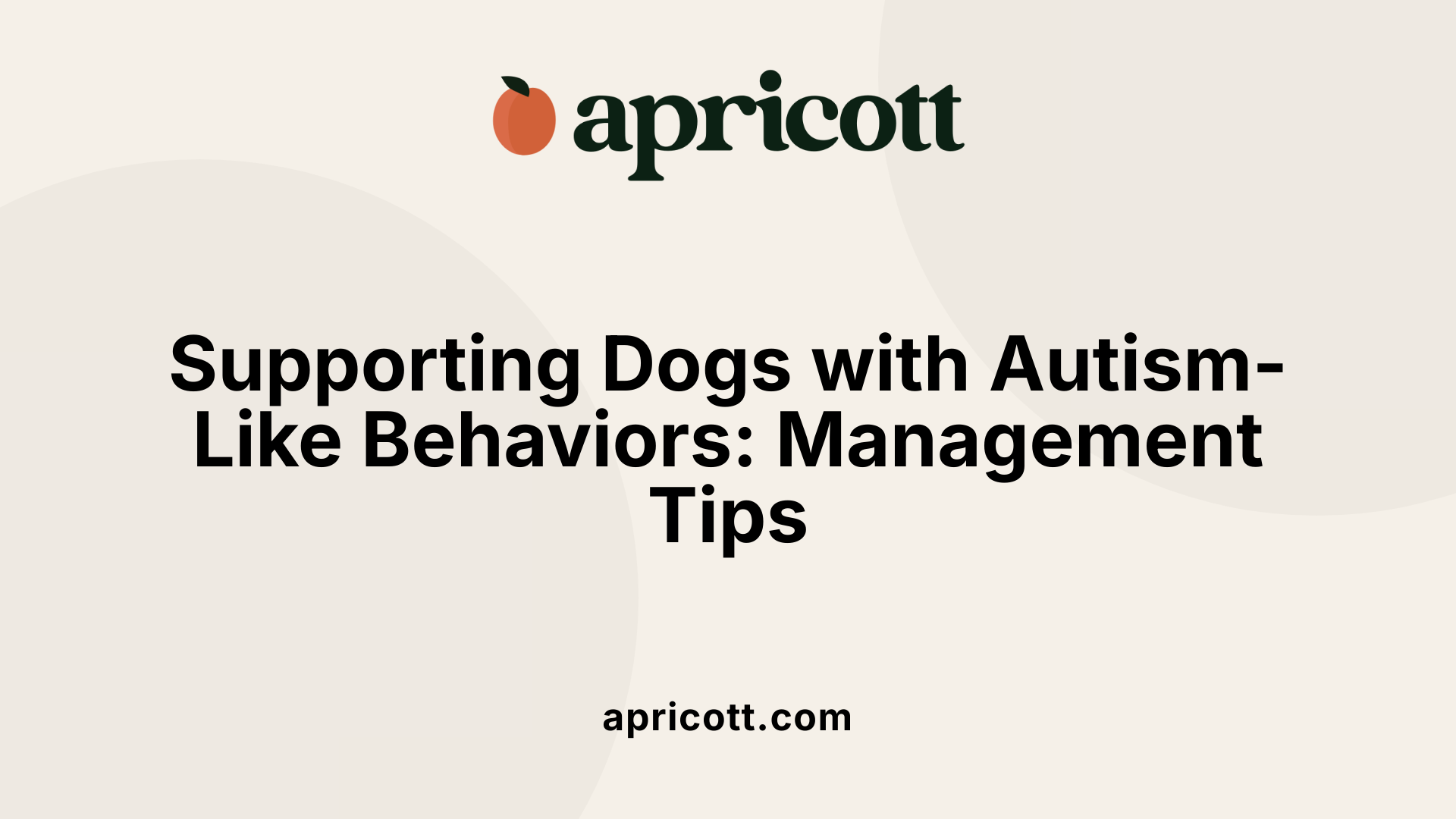July 31, 2025
Understanding Canine Behavioral Conditions and Myths Surrounding Autism
Many dog owners wonder if their pets can have autism or autism-like behaviors. While dogs cannot be diagnosed with autism in the human medical sense, they can exhibit behaviors that resemble autism, known as canine dysfunctional behavior (CDB). This article delves into what these behaviors entail, their causes, how to recognize them, and effective management strategies, clarifying common misconceptions along the way.

Dogs cannot be diagnosed with autism in the human sense, as autism is a condition specific to humans, characterized by challenges in social communication, repetitive behaviors, and sensory sensitivities. In contrast, dogs may display behaviors that resemble autism, such as repetitive actions, social withdrawal, or overreactions to stimuli.
These behaviors in dogs are often caused by other factors rather than autism itself. They are grouped under the term canine dysfunctional behavior (CDB). For instance, a dog that avoids eye contact or shows resistance to changes in routine might seem to have autism but is actually exhibiting CDB.
Common behaviors that are similar include:
It's important to recognize that these signs can arise from various causes, not necessarily from any neurological or developmental condition similar to human autism.
Dogs cannot be diagnosed with autism, as it is a condition unique to humans, characterized by specific challenges in social interaction, communication, and repetitive behaviors. However, dogs can display behaviors that resemble autism, often grouped under the term 'Canine Dysfunctional Behavior' (CDB).
Common signs include repetitive activities, such as tail chasing, excessive licking, or obsessive chewing. Some dogs may withdraw from social contact, avoiding eye contact or interaction with people and other animals. These avoidance behaviors can be mistaken for social difficulties similar to those seen in human autism.
Behavioral signs also include abnormal reactions to stimuli, such as overreacting to loud noises or new environments. Some dogs may enter trance-like states or show decreased physical activity, indicating possible neurological or emotional issues. They often react inappropriately to changes in their routine, resisting new experiences or settings.
Certain breeds, such as bull terriers and miniature poodles, appear to show these behaviors more frequently, which suggests there might be genetic or developmental factors involved. Typically, signs of CDB tend to emerge during puppyhood but can sometimes develop later in life due to stress, trauma, or health problems.
Many of these behaviors are thought to stem from a mixture of genetic predisposition, early-life experiences, neurological development issues, and environmental influences. Recognizing these signs early can help veterinarians and owners intervene effectively.
Addressing autism-like behaviors in dogs involves thorough assessment by a veterinarian to rule out physical health issues such as allergies, pain, or neurological problems. Once physical causes are eliminated, behavioral management strategies—like positive reinforcement training, environmental enrichment, routine, and patience—can help.
In some cases, medications or calming supplements may be recommended under professional supervision to help reduce anxiety or agitation. Overall, a combination of medical and behavioral guidance offers the best chance for improving the dog's quality of life.
 Dogs can display behaviors that resemble autism, but these do not equate to an autism diagnosis as in humans. Instead, such behaviors are often linked to other underlying health or environmental issues.
Dogs can display behaviors that resemble autism, but these do not equate to an autism diagnosis as in humans. Instead, such behaviors are often linked to other underlying health or environmental issues.
Several factors can contribute to autism-like behaviors, including genetic predispositions. Some breeds, such as Bull Terriers, are more prone to these behaviors, suggesting a hereditary component. Additionally, male dogs tend to show these behaviors more frequently.
Environmental influences also play a significant role. Stressful experiences in early life, poor socialization, and traumatic events can all increase the likelihood of exhibiting such behaviors. For instance, lack of proper interaction and enrichment can lead to avoidance behaviors or repetitive actions.
Neurological and physical health factors are also involved. Conditions like allergies, pain, canine cognitive dysfunction (CCD), or sensory issues can cause behaviors that mimic autism. Dogs experiencing discomfort or illness may react differently to their surroundings, showing signs such as avoiding eye contact or reacting poorly to changes.
Veterinarians use a thorough process—covering history, physical exams, blood tests, and imaging—to identify the root causes of these behaviors. Proper diagnosis is crucial because the behaviors are often due to treatable medical conditions or environmental factors rather than a neurological disorder akin to autism.
In summary, autism-like behaviors in dogs are generally attributable to a combination of genetic makeup, neurobiological factors, and environmental influences. Understanding these causes helps ensure affected dogs receive the appropriate treatment and behavioral management, improving their quality of life.

Autism in humans is a well-defined neurodevelopmental disorder with specific diagnostic criteria. It involves significant challenges in social communication, restricted interests, and repetitive behaviors, all assessed through behavioral evaluations and detailed developmental history. Clinicians use standardized tests to confirm diagnosis, emphasizing the underlying neurobiology.
In dogs, behaviors that resemble autism are not classified as an official disorder. Instead, veterinarians and behaviorists refer to these as signs of canine dysfunctional behavior (CDB). These may include repetitive actions like tail chasing or pacing, and social issues such as avoiding eye contact or reacting poorly to changes in routines.
While both species can show behaviors like withdrawal or repetitive activities, the causes, assessments, and implications differ greatly. In dogs, these behaviors are often caused by health issues such as allergies, anxiety, cognitive decline, or sensory problems, not a developmental disorder.
A veterinarian will carry out comprehensive examinations—blood tests, physical check-ups, and imaging—to determine whether health issues or environmental factors are influencing the behavior. This approach ensures that any underlying medical condition is addressed, which may alleviate the perceived 'autism-like' behaviors.
Understanding this distinction is essential for proper treatment. In humans, diagnosis leads to targeted therapies for neurodevelopmental challenges. In dogs, managing the behaviors involves behavioral modification, environmental enrichment, and sometimes medical treatment, but always guided by a professional assessment.
Summary: Although dogs can display behaviors similar to autism, these are typically caused by other health or environmental factors rather than a neurodevelopmental disorder. Proper diagnosis relies on veterinary evaluation, emphasizing health and behavioral causes over clinical labeling.

Research suggests that dogs can exhibit behaviors resembling autism spectrum disorder (ASD), but these are not the same as human autism. Instead, they are often classified as canine dysfunctional behaviors (CDB). These behaviors may stem from a mix of genetic factors, neurological issues, and environmental influences.
Genetic predispositions and early-life experiences play significant roles in shaping these behaviors. Conditions such as brain tumors, traumatic brain injuries, epilepsy, and hormonal imbalances can result in behavioral changes that mimic autism, including repetitive actions and social withdrawal. Additionally, impulsivity, hyperactivity, and attention difficulties—traits similar to ADHD in humans—have been observed in some dogs, indicating neurochemical and genetic parallels.
Studies also highlight the potential of dogs as models for neurodevelopmental research. Their behavioral responses and neurochemistry can help scientists understand conditions like ADHD and other behavioral disorders. Furthermore, animal-assisted therapies utilizing dogs have demonstrated how they can aid in improving social and behavioral skills, especially in children with autism or similar developmental challenges.
Overall, while dogs cannot be diagnosed with autism, studying their behavior provides valuable insights into neurodevelopmental disorders. These findings support the importance of comprehensive health evaluations for behavioral issues and reinforce the therapeutic potential of dogs in intervention strategies.

Owners often notice certain behaviors that resemble autism, such as repetitive actions like tail-chasing, pacing, or excessive licking. They might observe social withdrawal signs, including avoiding eye contact, not responding to commands, or showing antisocial behaviors. Changes in reactions to stimuli or unfamiliar environments can also be clues.
Additional indicators include trance-like states, increased aggression, or difficulty communicating feelings—like not wagging the tail when happy. Recognizing these behaviors early is crucial for effective management.
The first step is consulting a veterinarian or a certified canine behaviorist. They will conduct thorough diagnostics, including detailed history-taking, physical exams, blood tests, and imaging if needed, to rule out health issues like allergies, pain, or neurological problems.
Once a diagnosis such as canine dysfunctional behavior (CDB) is made, management involves multiple strategies. Creating a calm and predictable environment reduces stress. Ensuring routine activities and providing consistent training builds trust and stability.
Behavioral training techniques primarily focus on positive reinforcement, rewarding desirable behaviors, and gently discouraging negative or compulsive actions. Mental stimulation activities, like puzzle toys or scent games, help redirect repetitive behaviors.
Medical or pharmaceutical interventions may be considered if anxiety or compulsions are severe. Medications prescribed by a veterinarian can help manage symptoms, but they should always be part of an integrated behavior management plan.
Consistent support and patience from owners, alongside professional guidance, play vital roles in improving the emotional well-being of dogs exhibiting autism-like behaviors. Proper management can significantly enhance their quality of life and their relationship with their owners.
Dogs cannot be diagnosed with autism in the human sense. Autism is a recognized neurodevelopmental disorder that specifically affects humans, characterized by challenges in social communication, repetitive behaviors, and sensory sensitivities.
Although dogs may display behaviors that seem similar to autism—such as avoiding eye contact, resistance to change, or repetitive actions—these are not indicative of autism. Instead, such behaviors are often caused by other conditions or environmental factors.
Veterinarians use the term 'Canine Dysfunctional Behavior' (CDB) to describe unusual or atypical behavior patterns in dogs. CDB includes a range of signs like avoidance behaviors, resistance to routine changes, or overreactions to noises or surroundings.
Proper diagnosis involves a thorough veterinary assessment, including medical history, physical exams, blood tests, and imaging if necessary, to identify underlying causes such as allergies, anxiety, pain, or sensory issues. This process is essential to distinguish behavioral issues from medical problems and to determine appropriate treatment.
Many behaviors that appear to be similar to autism are actually linked to factors like poor socialization, lack of mental enrichment, stress, or health issues. Addressing these factors through proper training, environmental adjustments, and veterinary care can significantly improve a dog's well-being.
In conclusion, while some behaviors in dogs may resemble human autism, they are not the same disorder. Recognizing this helps ensure dogs receive the correct diagnosis and effective management, emphasizing health and behavioral interventions rather than misapplied labels.
Recognizing the differences between human autism and canine behaviors that may seem similar is vital for responsible pet ownership. While dogs cannot have autism as humans do, understanding, identifying, and managing autism-like behaviors through veterinary support, environmental adjustments, and positive training can significantly improve a dog’s quality of life. Staying informed and consulting professionals ensures that dogs receive appropriate care tailored to their specific needs.